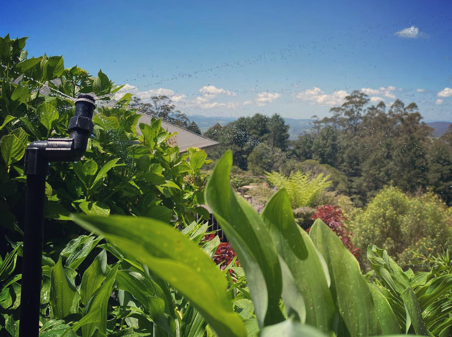Information
Hunter's MP Rotators.

TO DRIP OR NOT TO DRIP?
THAT IS THE QUESTION...
During the drought in Melbourne, water restrictions came into force, effectively banning the use of sprays in gardens. This caused a rush of people converting spray systems to drip. Unfortunately, it resulted in many 'fly by nighters' and 'cowboys' installing drip line who did not understand correct irrigation design. In some cases, previously efficient and well designed spray systems were converted to inefficient and poorly designed drip systems = more water wasted! (The desalination plant may avoid these sorts of restrictions in the future?).
As usual, the government went for a quick fix, knee jerk reaction that was far more rooted in public relations than actually looking at the causes of inefficiency of water usage. This area is complex and covers more than just water application and irrigation design, but we will save all the horticultural talk for another blog. Let's get back to the question, to drip or spray? The reality is that drip irrigation has the potential to be more water efficient by virtually eliminating evaporation and wind loss. The lower application rate is also advantageous for all soil profiles, again resulting in a higher efficiency.
However, drip still relies on management and this is one of the areas in which drip is more exposed to problems. It can suffer from what I call a case of 'out of sight, out of mind' syndrome. That's right, it gets forgotten about, and in many cases people are unwittingly irrigating all through winter. Another potential downside is that due to the longer run times, if the drip line is damaged, a leak can incur substantial water losses and in some cases go unnoticed for longer periods of time. It should be noted though that more recent advances in WiFi Controller technology have addressed these points with not only weather dictated irrigating but also leak detection technology.
Perhaps the biggest downside of drip irrigation is the issue of soil improvement. Most spray irrigation in garden beds involves only one trenched pipe down one edge of the garden bed. Whereas drip systems involve drip line pinned to the surface (under mulch) at 30-40cm intervals throughout the whole garden bed. This can be a cause of frustration with home owners as they unwittingly put shovels through the drip line when planting new plants or trying to dig in new compost to improve the soil. Sometimes drip irrigation is more practical from an installation perspective where trenching needs to be kept to a minimum. Sometimes it also makes sense to keep the water application rate as low as possible, like a steep slope and a heavy soil, where drip line is perfectly suited.
In regards to overhead (spray) systems, you have many options as to the type and style of outlets used, and this is where the consideration should be focussed. For instance, nozzle technology has come a long way, and more recent outlets like the Hunter MP Rotator provide a reasonably low application rate with a high radius. These outlets have become my 'go to' for larger garden beds and virtually all domestic lawn areas. I won't go into all the options here. I will only say that a well designed and installed spray system will still be extremely efficient and I would also argue that for many domestic installations, result in increased longevity (dependant on choice of components). I can advise and design with either application method, but in the end the decision for which method, rests with the client. Remember, either way the priority needs to be the quality of the design, components used and the installation standard.
The reality is the focus should be on the quality of the design and installation more so than the method. Both methods are fine if they are designed and installed properly. I will review the pros and cons shortly, but either option is good - providing it's designed and installed professionally and uses high quality components.

